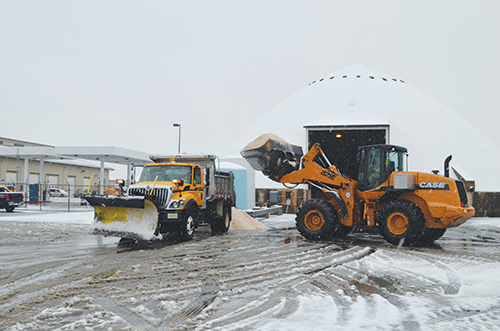Although Carroll County doesn’t usually see the snowfall totals that afflict other parts of the country, when the snow does fall, it can create just as much havoc on the roads. That is why, hours before the first flakes are predicted to fly, the county highway department goes to work, applying salt to about 973 miles of roads and 139 bridges.
“We have 63 snow routes, which include 50 county roads and 13 privately contracted routes,” said Ted Sirko, Carroll’s road operations chief. Sirko, who worked for the county’s Bureau of Engineering about five years before he was appointed as the chief of the highway department last year, said each winter storm presents different challenges, depending on whether the storm includes strong winds, and if the precipitation is freezing rain, sleet, snow – or a mix of all three.
In early January, as a snowstorm swept though the region, eventually dropping 2.5 to 4 inches of snow across the county, the highway department launched Phase I of its response about 3:30 a.m., before the snow started falling.
“We definitely had to take a look at where we are with this storm,” Sirko said at the time. He was concerned because temperatures were low, so road salt was not as effective as he would have liked. As the snow accumulated, the highway department shifted into Phase II: Plows began clearing the roadways, and salt application continued. At the time, Sirko said he expected his crews to be working into the next day.
The Jan. 6 snow was not the first of the winter weather to hit Carroll County hard enough to bring out state and county snow removal crews. On Nov. 26 – the day before Thanksgiving – an unanticipated, fast-moving winter storm passed through the area, blanketing the area with several inches of snow.
The storm caused traffic problems and disrupted flights throughout the East Coast for millions on the day before Thanksgiving – the busiest travel day of the year.
Henry Hobbs was behind the wheel of one of the about 80 county highway department snowplows working the storm. The nine-year employee of the highway department worked a snow removal route in the northern part of the county.
Hobbs divided his attention between driving, controlling the plow and listening for alerts from headquarters: Reports of cars off the road and of minor fender-benders were coming in from throughout the area.
In the midst of all the activity, Hobbs maintained steady progress, clearing the roads along his route.
“I enjoy being out and working alone,” Hobbs said. “We each have specific routes – mine takes about 1½ hours to complete before I have to go back to headquarters to top off with road salt.” He said his truck can haul 15 tons of salt.
“Sometimes we have to put chips (small stones) on the gravel roads to provide traction for vehicles,” Hobbs said. “You have to be on your toes – watching everything – when you’re driving.”
From the driver’s seat of his truck, Hobbs watched the road ahead, behind, and on both sides. A joystick controlled the height and angle of the position of the plow, and state-of-the-art electronics regulated the release of salt from the dump bed. CB communications equipment kept Hobbs in constant contact with headquarters.
“I prefer dealing with snow instead of sleet and freezing rain,” said Hobbs. “With ice storms, we have to deal with branches, trees and wires down everywhere. We’re responsible for cleaning up the downed trees and branches. Snowstorms aren’t usually too bad, but ice storms put a lot of weight on the trees.”
In addition to holding a commercial driving license, plow operators must be trained in first aid: It is not unusual for plow operators to assist stranded motorists, and render aid if necessary.
“If we see a stranded car or an accident, we stop to check and ask if they need assistance,” Hobbs said. “I had to use first aid skills once for an employee with head injuries.” During weather-related emergencies, county law enforcement personnel, emergency services and the highway department work together and share information about road conditions, accidents and related events, said Cpl. Jon Light of the county Sheriff’s Office.
They also inform the county’s emergency communications center about dangerous stretches of road. That information is then relayed to county and state highway crews, which allocate resources as needed.
“Occasionally, there are abandoned vehicles that are preventing plows from doing their jobs that we have to come out and handle as well,” Light said. “There is certainly overlap like that. In the past, we have had several times where a certain section of roadway on a hill became too slick to allow transportation up or down, so we’ll block off a section of roads temporarily until county crews can handle it. Communication goes both ways — we report bad sections of road and they report accidents.”
For more information on Carroll County Bureau of Roads Operations: ccgovernment.carr.org/ccg/roads. For more information on the Carroll County Sheriff’s Office: ccgovernment.carr.org/ccg/sheriff.

